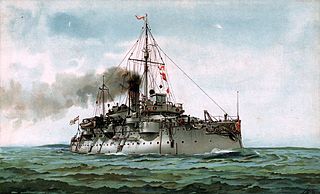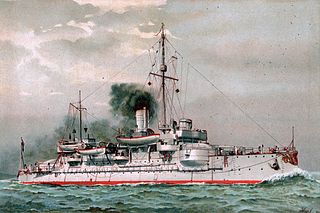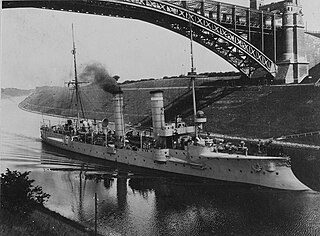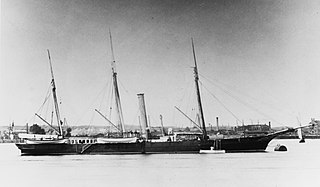
SMS Siegfried was the lead ship of the six-member Siegfried class of coastal defense ships built for the German Imperial Navy. Her sister ships were Beowulf, Frithjof, Heimdall, Hildebrand, and Hagen. Siegfried was built by the Germaniawerft shipyard between 1888 and 1890, and was armed with a main battery of three 24-centimeter (9.4 in) guns. She served in the German fleet throughout the 1890s and was rebuilt in 1903 - 1904. She served in the VI Battle Squadron after the outbreak of World War I in August 1914, but saw no action. Siegfried was demobilized in 1915 and used as a barracks ship thereafter. She was ultimately broken up for scrap in 1920.

SMS Ägir was the second and final member of the Odin class of coastal defense ships built for the Imperial German Navy. She had one sister ship, Odin. Ägir was named for the norse god, and was built by the Kaiserliche Werft in Danzig between 1893 and 1896. She was armed with a main battery of three 24-centimeter (9.4 in) guns. She served in the German fleet throughout the 1890s and was rebuilt in 1901–1903. She served in the VI Battle Squadron after the outbreak of World War I in August 1914, but saw no action. Ägir was demobilized in 1915 and used as a tender thereafter. After the war, she was rebuilt as a merchant ship and served in this capacity until December 1929, when she was wrecked on the island of Gotland.

SMS Undine was the last member of the ten-ship Gazelle class of light cruisers that were built for the German Kaiserliche Marine in the late 1890s and early 1900s. The Gazelle class was the culmination of earlier unprotected cruiser and aviso designs, combining the best aspects of both types in what became the progenitor of all future light cruisers of the Imperial fleet. Built to be able to serve with the main German fleet and as a colonial cruiser, she was armed with a battery of ten 10.5 cm (4.1 in) guns and had a top speed of 21.5 knots. Undine was a modified version of the basic Gazelle design, with improved armor and additional coal storage for a longer cruising range.

SMS Wörth was one of four German pre-dreadnought battleships of the Brandenburg class, built in the early 1890s. The class also included Brandenburg, Kurfürst Friedrich Wilhelm, and Weissenburg. The ships were the first ocean-going battleships built for the Kaiserliche Marine. Wörth was laid down at the Germaniawerft dockyard in Kiel in May 1890. The ship was launched on 6 August 1892 and commissioned into the fleet on 31 October 1893. Wörth and her three sisters carried six heavy guns rather than four, as was standard for most other navies' battleships. She was named for the Battle of Wörth fought during the Franco-Prussian War of 1870–1871.

SMS Brandenburg was the lead ship of the Brandenburg-class pre-dreadnought battleships, which included Kurfürst Friedrich Wilhelm, Weissenburg, and Wörth, built for the German Kaiserliche Marine in the early 1890s. She was the first pre-dreadnought built for the German Navy; earlier, the navy had only built coastal defense ships and armored frigates. The ship was laid down at the AG Vulcan dockyard in 1890, launched on 21 September 1891, and commissioned into the German Navy on 19 November 1893. Brandenburg and her three sisters were unique for their time in that they carried six heavy guns instead of the four that were standard in other navies. She was named after the Province of Brandenburg.

SMS Wittelsbach was the lead ship of the Wittelsbach class of pre-dreadnought battleships, built for the Imperial German Navy. She was the first capital ship built under the Navy Law of 1898, brought about by Admiral Alfred von Tirpitz. Wittelsbach was laid down in 1899 at the Wilhelmshaven Navy Dockyard and completed in October 1902. She was armed with a main battery of four 24 cm (9.4 in) guns and had a top speed of 18 knots.

SMS Sachsen was the lead ship of her class of four ironclads of the German Kaiserliche Marine. Her sisterships were Bayern, Württemberg, and Baden. Sachsen was built in the AG Vulcan shipyard in Stettin. She was laid down in April 1875, launched on 21 July 1877, and commissioned on 21 October 1878. The ship was armed with a main battery of six 26 cm (10.2 in) guns in individual open mounts.

SMS Württemberg was one of four Sachsen-class armored frigates of the German Kaiserliche Marine. Her sister ships were Sachsen, Bayern, and Baden. Württemberg was built in the AG Vulcan shipyard in Stettin from 1876 to 1881. The ship was commissioned into the Imperial Navy in August 1881. She was armed with a main battery of six 26 cm (10.2 in) guns in two open barbettes.

SMS Beowulf was the second vessel of the six-member Siegfried class of coastal defense ships built for the German Imperial Navy. Her sister ships were Siegfried, Frithjof, Heimdall, Hildebrand, and Hagen. Beowulf was built by the AG Weser shipyard between 1890 and 1892, and was armed with a main battery of three 24-centimeter (9.4 in) guns. She served in the German fleet throughout the 1890s and was rebuilt in 1900 – 1902. She served in the VI Battle Squadron after the outbreak of World War I in August 1914, but saw no action. Beowulf was demobilized in 1915 and used as a target ship for U-boats thereafter. She was ultimately broken up for scrap in 1921.

SMS Frithjof was the third vessel of the six-member Siegfried class of coastal defense ships built for the German Imperial Navy. Her sister ships were Siegfried, Beowulf, Heimdall, Hildebrand, and Hagen. Frithjof was built by the AG Weser shipyard between 1890 and 1893, and was armed with a main battery of three 24-centimeter (9.4 in) guns. She served in the German fleet throughout the 1890s and was rebuilt in 1900 - 1902. She served in the VI Battle Squadron after the outbreak of World War I in August 1914, but saw no action. Frithjof was demobilized in 1915 and used as a barracks ship thereafter. She was rebuilt as a merchant ship in 1923 and served in this capacity until she was broken up for scrap in 1930.

SMS Hagen was the final vessel of the six-member Siegfried class of coastal defense ships built for the German Imperial Navy. Her sister ships were Siegfried, Beowulf, Frithjof, Heimdall, and Hildebrand. Hagen was built by the Kaiserliche Werft in Kiel between 1891 and 1893, and was armed with a main battery of three 24-centimeter (9.4 in) guns. She served in the German fleet throughout the 1890s and was rebuilt in 1900 - 1902. She served in the VI Battle Squadron after the outbreak of World War I in August 1914, but saw no action. Hagen was demobilized in 1915 and used as a barracks ship thereafter. She was ultimately sold for scrap in 1919 and subsequently dismantled.

SMS Medusa was a member of the ten-ship Gazelle class of light cruisers that were built for the German Kaiserliche Marine in the late 1890s and early 1900s. The Gazelle class was the culmination of earlier unprotected cruiser and aviso designs, combining the best aspects of both types in what became the progenitor of all future light cruisers of the Imperial fleet. Built to be able to serve with the main German fleet and as a colonial cruiser, she was armed with a battery of ten 10.5 cm (4.1 in) guns and a top speed of 21.5 knots. Medusa served in all three German navies—the Kaiserliche Marine, the Reichsmarine of Weimar Germany, and the Kriegsmarine of Nazi Germany—over the span of over forty years.

SMS Amazone was the sixth member of the ten-ship Gazelle class of light cruisers that were built for the German Kaiserliche Marine in the late 1890s and early 1900s. The Gazelle class was the culmination of earlier unprotected cruiser and aviso designs, combining the best aspects of both types in what became the progenitor of all future light cruisers of the Imperial fleet. Built to be able to serve with the main German fleet and as a colonial cruiser, she was armed with a battery of ten 10.5 cm (4.1 in) guns and a top speed of 21.5 knots.

SMS Nymphe was the third member of the ten-ship Gazelle class of light cruisers that were built for the German Kaiserliche Marine in the late 1890s and early 1900s. The Gazelle class was the culmination of earlier unprotected cruiser and aviso designs, combining the best aspects of both types in what became the progenitor of all future light cruisers of the Imperial fleet. Built to be able to serve with the main German fleet and as a colonial cruiser, she was armed with a battery of ten 10.5 cm (4.1 in) guns and a top speed of 21.5 knots.

SMS Stein was a Bismarck-class corvette built for the German Imperial Navy in the late 1870s. The ship was named after the Prussian statesman Heinrich Friedrich Karl vom und zum Stein. She was the sixth member of the class, which included five other vessels. The Bismarck-class corvettes were ordered as part of a major naval construction program in the early 1870s, and she was designed to serve as a fleet scout and on extended tours in Germany's colonial empire. Stein was laid down in 1878, launched in September 1879, and was commissioned into the fleet in October 1880. She was armed with a battery of twelve 15 cm (5.9 in) guns and had a full ship rig to supplement her steam engine on long cruises abroad.

SMS Baden was one of four Sachsen-class armored frigates of the German Kaiserliche Marine. Her sister ships were Sachsen, Bayern, and Württemberg. Baden was built in the Kaiserliche Marine in Kiel from 1876 to 1883. The ship was commissioned into the Imperial Navy in September 1883. She was armed with a main battery of six 26 cm (10.2 in) guns in two open barbettes.

SMS Blitz was an aviso of the German Kaiserliche Marine built in the early 1880s. She was the lead ship of her class, which included one other vessel, SMS Pfeil. Her primary offensive armament consisted of a bow-mounted torpedo tube, and she was armed with a battery of light guns to defend herself against torpedo boats, a sign of the growing importance of torpedoes as effective weapons in the period. The Blitz class featured a number of innovations in German warship design: they were the first steel hulled warships and the first cruiser-type ships to discard traditional sailing rigs.

SMS Pfeil was an aviso of the Imperial German Navy, the second and final member of the Blitz class. Her primary offensive armament consisted of a bow-mounted torpedo tube, and she was armed with a battery of light guns to defend herself against torpedo boats, a sign of the growing importance of torpedoes as effective weapons in the period. The Blitz class featured a number of innovations in German warship design: they were the first steel hulled warships and the first cruiser-type ships to discard traditional sailing rigs.

SMS Wacht was an aviso of the Imperial German Navy, the lead ship of her class. She had one sister ship, Jagd. Wacht was built by the AG Weser shipyard; she was laid down in 1886, launched in August 1887, and commissioned in August 1888. She served in the active fleet through the 1890s and participated in numerous training exercises. Her career was cut short on 4 September 1901, when she collided with the old ironclad SMS Sachsen. The latter's ram bow holed Wacht under the waterline and caused her to rapidly sink. Her crew was safely rescued, however, and there were no casualties.

SMS Grille was an aviso of the Prussian Navy built in France in the mid-1850s as part of a naval expansion program directed by Prince Adalbert of Prussia, who saw the need for a stronger fleet. She was authorized in 1855 in the aftermath of the First Schleswig War, which had demonstrated the weakness of the Prussian fleet. Grille was the first screw propeller-driven steamship to be built for Prussia; all earlier steam-powered vessels had been paddle steamers.

























